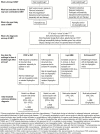Breakthrough Invasive Mold Infections in the Hematology Patient: Current Concepts and Future Directions
- PMID: 29860307
- PMCID: PMC6206100
- DOI: 10.1093/cid/ciy473
Breakthrough Invasive Mold Infections in the Hematology Patient: Current Concepts and Future Directions
Abstract
Although the widespread use of mold-active agents (especially the new generation of triazoles) has resulted in reductions of documented invasive mold infections (IMIs) in patients with hematological malignancies and allogeneic hematopoietic stem cell transplantation (HSCT), a subset of such patients still develop breakthrough IMIs (bIMIs). There are no data from prospective randomized clinical trials to guide therapeutic decisions in the different scenarios of bIMIs. In this viewpoint, we present the current status of our understanding of the clinical, diagnostic, and treatment challenges of bIMIs in high-risk adult patients with hematological cancer and/or HSCT receiving mold-active antifungals and outline common clinical scenarios. As a rule, managing bIMIs demands an individualized treatment plan that takes into account the host, including comorbidities, certainty of diagnosis and site of bIMIs, local epidemiology, considerations for fungal resistance, and antifungal pharmacological properties. Finally, we highlight areas that require future investigation in this complex area of clinical mycology.
Figures


References
-
- Kontoyiannis DP, Marr KA, Park BJ, et al. . Prospective surveillance for invasive fungal infections in hematopoietic stem cell transplant recipients, 2001–2006: overview of the Transplant-Associated Infection Surveillance Network (TRANSNET) Database. Clin Infect Dis 2010; 50:1091–100. - PubMed
-
- Sipsas NV, Kontoyiannis DP. Clinical issues regarding relapsing aspergillosis and the efficacy of secondary antifungal prophylaxis in patients with hematological malignancies. Clin Infect Dis 2006; 42:1584–91. - PubMed
-
- Cornely OA, Maertens J, Winston DJ, et al. . Posaconazole vs. fluconazole or itraconazole prophylaxis in patients with neutropenia. N Engl J Med 2007; 356:348–59. - PubMed
-
- Ullmann AJ, Lipton JH, Vesole DH, et al. . Posaconazole or fluconazole for prophylaxis in severe graft-versus-host disease. N Engl J Med 2007; 356:335–47. - PubMed
Publication types
MeSH terms
Substances
LinkOut - more resources
Full Text Sources
Other Literature Sources
Research Materials

